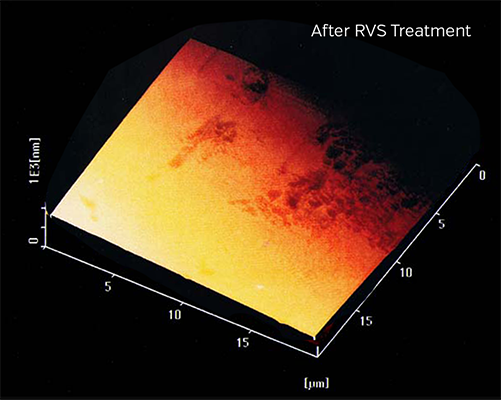RVS Technology treatments lasts at least 60,000 miles per treatment!
RVS Technology integrates with the original surface creating a mirror-like Triboceramic surface on the friction zones of mechanisms. As a result a worn mechanism is restored to near or original specification due to friction decreasing with tolerances and compression restoring to, or close to original specification.

Add half of the RVS mixture to a warm engine

Let your engine idle for 15 minutes
Add remaining RVS mixture and drive for 30 minutes
BREAKING DOWN FRICTION
Building new material, not polishing! RVS Technology treatment grows new surface material to all those friction surfaces that are in contact with the oil. The metal ceramic surface is formed only in the areas in which there is friction and the abrasion occurs only in those areas where the surface has breaking peaks in the surface. In addition, the new surface created is much harder and smoother than the original. Seen here is a laser microscope image of a camshaft before and after RVS Technology treatment.


FREQUENTLY ASKED QUESTIONS
RVS Technology® Tribo(nano-)Ceramics can be considered as an advanced mode of cure for engines, gearboxes, and other mechanisms. If your device has normal wear problems like noise, smoking, too high consumption of oil or fuel, decrease of power and compression level, unbalance and vibrations RVS Technology has the capacity to restore it.
RVS Technology works also as a preventive method, protecting your mechanisms against coming wear. For example treatment of car parts will protect your car from serious problems in the future.
Restores Vital Surfaces
No! Unlike oil additives on the market, RVS Technology® products produce a nano-ceramic layer that integrates with the metal friction surfaces of your engine, transmission, differential etc. That’s why it lasts at least 60,000 miles (or 2500 hours in machinery) and oil changes do not affect it. RVS does not affect the properties of oil. The idea of oil additives is to improve the oil’s properties and have to be re-applied at every oil change.
I was initially a bit skeptical in buying this product. The reviews were good but I had never heard of the product nor the technology. I purchased RVS for the transmission in my 2009 Cadillac ESV with 160K miles, I followed the directions to add it after a transmission service. Wow, what an amazing difference! The transmission shifted much more smoothly, so smoothly I could no longer detect it shifting unless I was looking at the tach. After that experience I added RVS to both differentials, the transfer case, power steering, and the engine oil. WOW again! The car drives so smoothly and quietly. It literally feels like a new car again. It is so smooth and quiet I really only notice road and wind noise.
2.5-3 mpgs increase on a Toyota Prius. Whats not to like.
I have been using RVS Technology for about 3 years now. I have used it on Class 8 Engines and Transmissions. My experience has been nothing but the best. I am currently driving a 2012 Peterbilt 386 Cummins ISX 12 with 975,000 miles and Running Extremely Strong. I asked an affiliate what was the most mileage he has seen on a class 8 engine with RVS Technology and he replied 3 million plus miles…WOW…If you are serious about your business you need to secure your most valuable asset (your engine) Stop wasting your money on additives and protect all your engine and transmission components with RVS Technology…You’ll feel the difference right away…
“I performed an RVS treatment to my car’s engine that has 230,000km (145k miles) and I am beyond thrilled! I already thought about replacing my hydraulic valve train, but after the treatment, their sound and vibration disappeared. At the same time, the torque down low in the power band increased noticeably and the engine idling became smoother”
“I performed treatments to my old Pontiac Trans Am and my 1984 Honda Magna. Could not be happier with the results! Trans Am runs much smoother and the Honda recorded 3 mpg better mileage and it also got a measured increase in compression in all cylinders and added power.”
“I have a 2004 Toyota 4Runner with the V8 and 4wd that I performed RVS treatments to. I performed treatments to the differentials (used one P2 product per transaxle), engine (2 x G6), transmission (T6A) and power steering (P2). My truck has 200k miles and mileage had dipped to 13.5 mpg on average. My truck now gets 17 mpg and literally runs like new if not better. Cannot believe how smooth it is!”